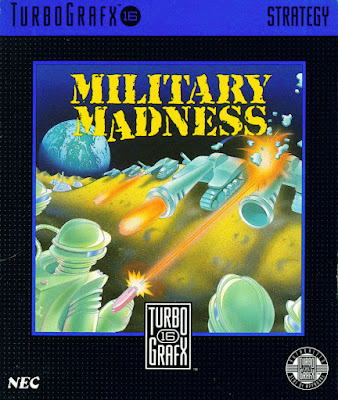 |
| Begun, this cheese war has... |
The idea of fighting a conventional war on the moon presents some unique factors that could make for an intriguing strategy game. For one thing, Luna's gravity is only 16.6 percent that of Earth's. This means a M1 Abrams tank only weights about as much as a fully-loaded F-16 fighter jet. Additionally, the diameter of the moon is only about a quarter that of Earth so the horizon is roughly twice as near assuming you are standing on a flat plain. The lack of an atmosphere means providing adequate cooling/heating for vehicles is tricky and would almost certainly involve highly vulnerable radiators (A.K.A. glowing weak points). Guided munitions would require some alterations to implement effectively as well though, oddly enough, more conventional weaponry like guns and rockets would work mostly the same. Perhaps because of that last factor, Nectaris (despite being a game about Lunar warfare) has a fairly bog-standard lineup of combat units. There are two types of armed moon buggy, two anti-aircraft vehicle configurations (flak and missile), three types of infantry (light, heavy, and motorbike), seven kinds of tank (running the gamut from light to heavy with the biggest able to engage flying targets), two types of unarmed transport (one flying and the other ground-based), three dedicated aircraft (fighter, bomber, and a hybrid of both) and two types of mobile artillery (rocket and gun). Other than that the only other units are mines and fixed gun emplacements. Mines are a bit out-of-the-ordinary in that they only serve to block enemy movement until cleared away by concentrated weapons fire. Tanks lack scoops on their treads which seems strange considering how silty Lunar soil is. That's a minor quibble though compared to the aircraft which (aerodynamic appearance and all) look out of place to me. Considering the aforementioned battlefield conditions, the line between moving on the ground and through the sky should be much blurrier. There's no reason why infantry or even certain vehicles couldn't be outfitted with jump jets to hop or skip across the surface, though using them too liberally could entail certain risks such as being out of cover and more easily detected by radar. On the plus side, popping up could provide units with better line-of-sight given the short horizon...not to mention a temporary height advantage.
 |
| "Robbie" infantry in the foreground engage "Bison" tanks in the background |
I know it seems like I'm being unfairly down on Nectaris, but it's because there are a lot of squandered opportunities that could have helped make it standout. I think the lack of creativity and unwillingness to apply real science kept this IP from achieving much in the form of distinction from mechanically similar Japanese strategy games out at the time like Hybrid Front and the Daisenryaku series. Hopefully, someone will come along and tackle the premise with a bit more gusto in the future. As for the Nectaris IP, it's held by Konami so don't expect them to do much with it anytime soon.
 |
| "Nectaris" is Latin for "Nectar", but the name comes from the "Mare Nectaris" region of the moon in which the game takes place |
No comments:
Post a Comment